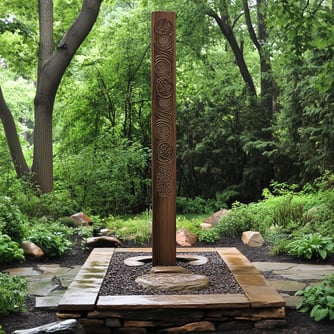Asherah - Mother of the Gods: Erased by Men
Unveil the legacy of Asherah, the "Forgotten Goddess" once revered as a divine mother and consort of El. This post explores her journey from a central deity in ancient worship to her erasure from religious texts. Discover her symbolic ties to sacred trees, fertility, and the divine feminine, and learn how modern spirituality is reclaiming her presence. Dive into a story of hidden divinity that still echoes in nature, ritual, and spiritual balance today.
GODDESSES
Goddess Hive
12/21/20246 min read


Welcome, Goddess Hive! Some links in this blog are affiliate links. Meaning, if you choose to shop through the links on this page, a small percentage of the sale will go to me at no additional cost to you. Thank you for your support. Goddess bless.
The Forgotten Goddess: Asherah’s Journey from Revered Deity to Hidden Figure
Imagine a world where the whispers of the divine feminine flow through the rustle of leaves and the steady strength of ancient trees. Here, we meet Asherah — a Goddess of fertility, motherhood, and sacred femininity. In the vast tapestry of ancient mythology and religion, Asherah emerges as a compelling yet mysterious figure. Once honored as a beloved deity of Canaanite and early Israelite worship, her name was etched in prayers and carved into sacred spaces.
Over time, as patriarchal tides rose, and sought to turn the world toward one deity, Asherah’s presence was hidden, her story fragmented into artifacts and subtle scriptural echoes. Today, we invite you to journey into the enduring mystery of Asherah and reflect on her role in the divine feminine tradition. Her legacy — a tale of resilience, mystery, and the unyielding power of the divine feminine.
Who is Asherah?
Asherah was a major Goddess in Canaanite religion and is believed to have held a significant place in early Israelite worship. Known as the "Lady of the Sea" or "Mother of the Gods," she was a Goddess of fertility, motherhood, and protection. In Ugaritic texts, she is described as the consort of El, the chief god, and was later associated with Yahweh in some Israelite inscriptions.
Evidence of Asherah’s worship is found in both archaeological and textual sources. Artifacts such as the Ta’anach cult stand and Judean pillar figurines reflect her connection to fertility, with representations of naked female figures often linked to her worship. These images often depict women with exaggerated breasts, symbolizing nourishment and life-giving power. Sacred tree imagery also plays a central role, as Asherah was associated with stylized trees, poles, and groves used in religious rituals (10†source) (12†source).
Asherah and the Sacred Tree
One of the most iconic symbols of Asherah is the "asherah pole," a sacred object often associated with trees. Biblical references frequently mention these poles as objects that were planted, raised, and later cut down or destroyed as part of religious reforms. The Hebrew Bible links these poles with the worship of Asherah and frequently criticizes them as symbols of idolatry. The term "asherim" (plural of asherah) appears in several biblical passages, often describing the destruction of these cult objects during religious purges led by kings like Josiah (2 Kings 23:6) (12†source).
The association with trees extends to the Garden of Eden narrative. Some scholars draw parallels between Asherah and the Tree of Life, noting that both are symbols of life, knowledge, and the feminine divine. The Hebrew word ela, meaning "terebinth tree," echoes Asherah’s Canaanite epithet elat, a term meaning "Goddess." This linguistic connection hints at the enduring influence of Asherah’s imagery in Israelite tradition (12†source).
Asherah as Consort of Yahweh
Perhaps one of the most controversial aspects of Asherah’s story is her connection to Yahweh. Inscriptions found at sites like Kuntillet ‘Ajrud and Khirbet el-Qom invoke blessings "by Yahweh and his Asherah." These discoveries sparked significant debate among scholars, as they suggest that Asherah may have been viewed as Yahweh's consort in some strands of early Israelite worship(10†source) (11†source).
This relationship is further supported by archaeological evidence, including graffiti on storage jars and inscriptions in tombs. Some scholars interpret these inscriptions to mean that Asherah was seen as a divine partner or feminine counterpart to Yahweh, though this view was later suppressed by Israelite religious reformers who sought to establish a monotheistic worship system(11†source).
Why Was Asherah Erased?
The erasure of Asherah from religious texts can be linked to the religious reforms of the Deuteronomic period. During this era, the push for monotheism intensified, and worship of deities other than Yahweh was condemned. Texts like 2 Kings 23:6 recount how King Josiah "brought out the Asherah from the house of the Lord... and burned it," signifying the physical and symbolic destruction of her presence within the temple of Yahweh (12†source).
Religious leaders sought to establish Yahweh as the sole, unrivaled deity. As part of this process, figures like Asherah, Baal, and other Canaanite deities were demonized or erased. The physical removal of her sacred objects from worship sites paralleled the erasure of her name from religious texts. However, archaeological finds, inscriptions, and surviving polemics in biblical texts hint that her influence lingered for centuries(10†source) (12†source).
Asherah’s Modern Relevance
In recent years, Asherah has reemerged as a symbol of feminine power, fertility, and divine balance. Modern spiritual movements and feminist theologies recognize her as a representation of the "lost Goddess" archetype—a symbol of the repressed feminine aspect of the divine. Her story invites modern seekers to question the patriarchal structures that shaped religious texts and to explore the role of the feminine divine in spirituality today.
Her connection to sacred trees and natural cycles makes her a fitting figure for modern eco-spirituality and Goddess worship. Many who honor Asherah today do so by planting trees, creating symbolic groves, or crafting rituals that honor the feminine aspect of divinity in their spiritual practices.
Ways to Connect with Asherah in Daily Life
If you feel drawn to connect with the energy of Asherah, consider these practices:
Create a Sacred Space: Place a symbolic tree, branch, or carved wooden object in your home altar as a representation of Asherah’s sacred tree.
Nurture Life: Plant a tree in your garden or support reforestation efforts as a living symbol of Asherah’s enduring power.
Honor the Feminine Divine: Meditate on the qualities of nourishment, protection, and feminine wisdom. Invoke Asherah’s energy in prayers and rituals that focus on growth, balance, and abundance.
Embrace Fertility Symbols: Use motifs of vines, roots, or flowering plants in home décor, art, or jewelry to remind you of Asherah’s presence.
Asherah’s story is one of erasure and reclamation. Once a revered Goddess of fertility, motherhood, and divine femininity, she was later obscured by the forces of religious reform. Yet, traces of her presence endure—in archaeological finds, linguistic echoes, and feminist reinterpretations of sacred texts. Her story calls on us to honor the balance of divine masculine and feminine energies and to recognize the importance of what has been hidden or forgotten. Through Asherah, we are reminded of the life-giving power of the natural world and the enduring strength of the feminine divine.
FAQ About Asherah
1. Was Asherah a Goddess or a symbol? Asherah was both. She was a Goddess in Canaanite and early Israelite religion, as well as a cult symbol represented by sacred trees, poles, and figurines(10†source) (12†source).
2. Why was Asherah removed from the Bible? Asherah was removed as part of religious reforms aimed at promoting monotheism. Kings like Josiah ordered the destruction of Asherah’s cult objects to ensure exclusive worship of Yahweh (12†source).
3. Is Asherah mentioned in the Bible? Yes, though not explicitly as a Goddess. The term "asherah" often refers to sacred poles or trees used in her worship. References to these objects appear over 30 times in the Hebrew Bible (12†source).
4. What does Asherah represent today? For many modern spiritual seekers, Asherah symbolizes the divine feminine, fertility, and nature's cycles. Her association with trees makes her an emblem of ecological spirituality and Goddess worship.
5. How can I honor Asherah in my spiritual practice? You can honor Asherah by creating a sacred space with tree imagery, planting a tree, or incorporating fertility and growth symbols into your rituals. Asherah represents balance, nourishment, and divine wisdom.
This blog post sheds light on Asherah’s history, her role as a Goddess, and the mystery of her erasure from religious texts. Her story serves as a testament to the enduring power of the divine feminine—a force that, despite attempts to silence it, continues to grow and flourish.
If you'd like more detailed academic perspectives on Asherah, you can review sources from the Center for Online Judaic Studies (10†source), Biblical Archaeology Society (11†source), and the Jewish Women’s Archive (12†source).





About us
The content provided on OMG, including blog posts, rituals, prayers, meditations, and other materials, is intended for informational, educational, and spiritual enrichment purposes only. It is not a substitute for professional medical advice, diagnosis, or treatment. If you have any concerns regarding your physical or mental health, please consult a qualified healthcare profession.
Take care of yourself first, then take care of everyone else. That is the nature of Goddess-ship.
Be well. Goddess Bless.
Empowerment
Empowering femininity through education and self-care.
Goddess
goddesshive@ohmygoddess.com
© 2024. All rights reserved.
